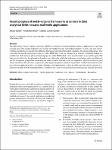Item Infomation
Full metadata record
| DC Field | Value | Language |
|---|---|---|
| dc.contributor.author | Alessio, Zuliani | - |
| dc.contributor.author | Noureddine, Khiar | - |
| dc.contributor.author | Carolina, Carrillo-Carrión | - |
| dc.date.accessioned | 2023-04-20T02:22:57Z | - |
| dc.date.available | 2023-04-20T02:22:57Z | - |
| dc.date.issued | 2023 | - |
| dc.identifier.uri | https://link.springer.com/article/10.1007/s00216-022-04493-7 | - |
| dc.identifier.uri | https://dlib.phenikaa-uni.edu.vn/handle/PNK/8116 | - |
| dc.description | CC BY | vi |
| dc.description.abstract | The deployment of metal–organic frameworks (MOFs) in a plethora of analytical and bioanalytical applications is a growing research area. Their unique properties such as high but tunable porosity, well-defined channels or pores, and ease of post-synthetic modification to incorporate additional functional units make them ideal candidates for sensing applications. This is possible because the interaction of analytes with a MOF often results in a change in its structure, eventually leading to a modification of the intrinsic physicochemical properties of the MOF which is then transduced into a measurable signal. The high porosity allows for the adsorption of analytes very efficiently, while the tunable pore sizes/nature and/or installation of specific recognition groups allow modulating the affinity towards different classes of compounds, which in turn lead to good sensor sensitivity and selectivity, respectively. | vi |
| dc.language.iso | en | vi |
| dc.publisher | Springer | vi |
| dc.subject | MOFs | vi |
| dc.title | Recent progress of metal–organic frameworks as sensors in (bio)analytical fields: towards real-world applications | vi |
| dc.type | Book | vi |
| Appears in Collections | ||
| OER - Khoa học Tự nhiên | ||
Files in This Item:

